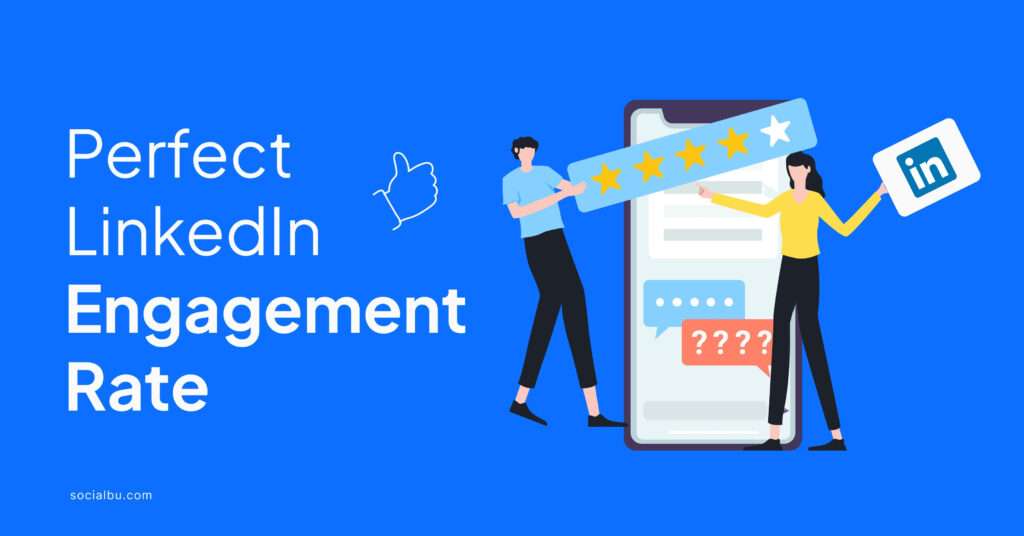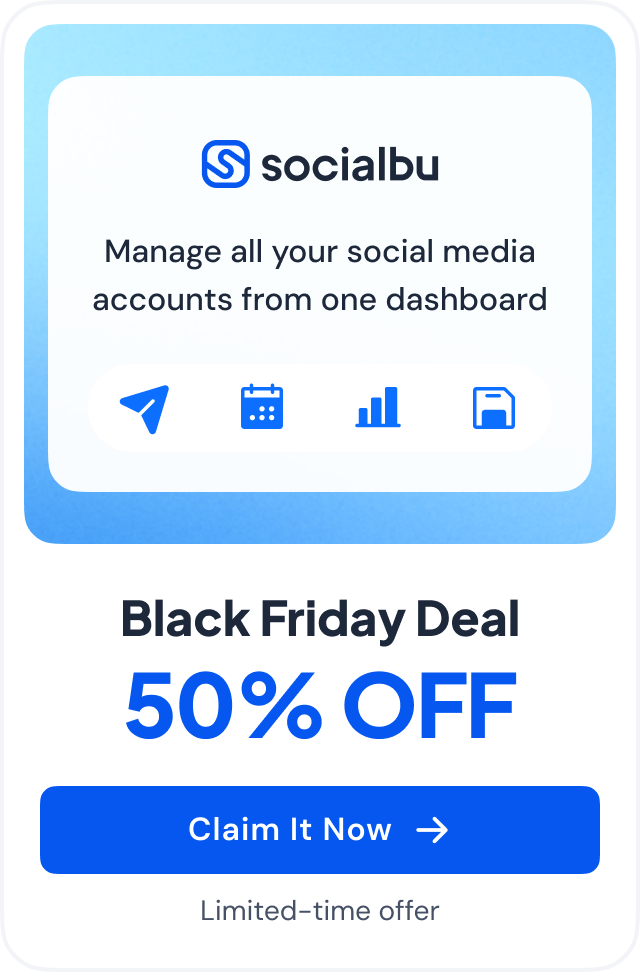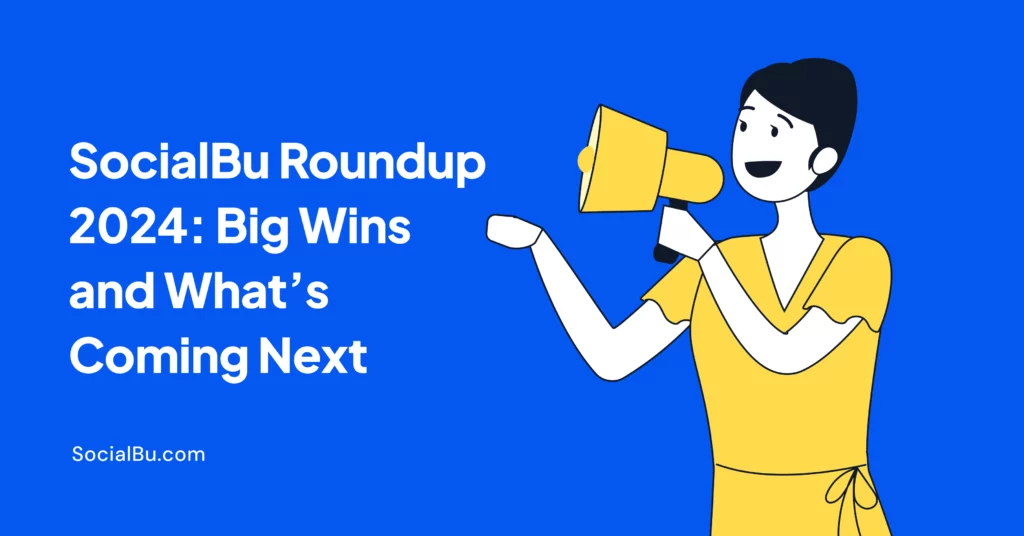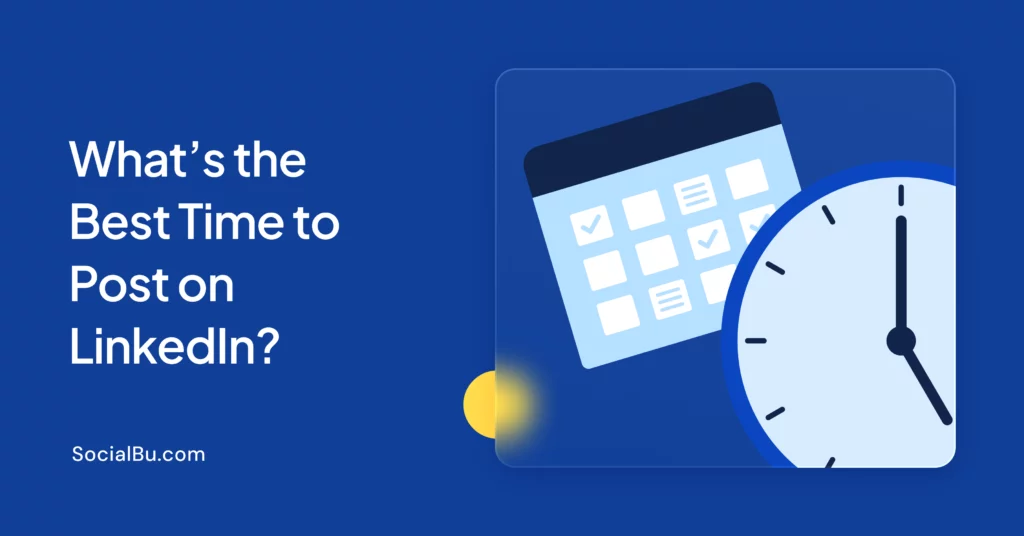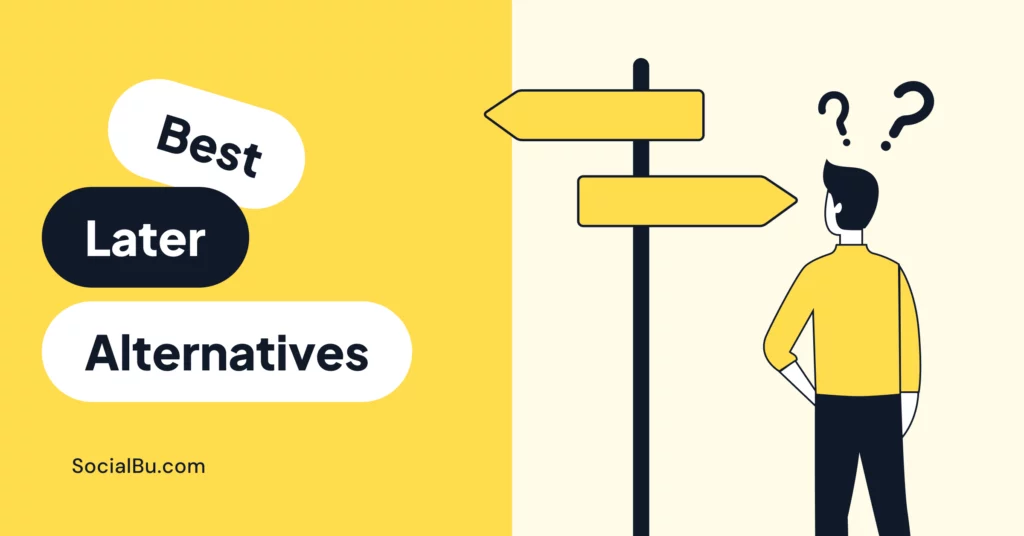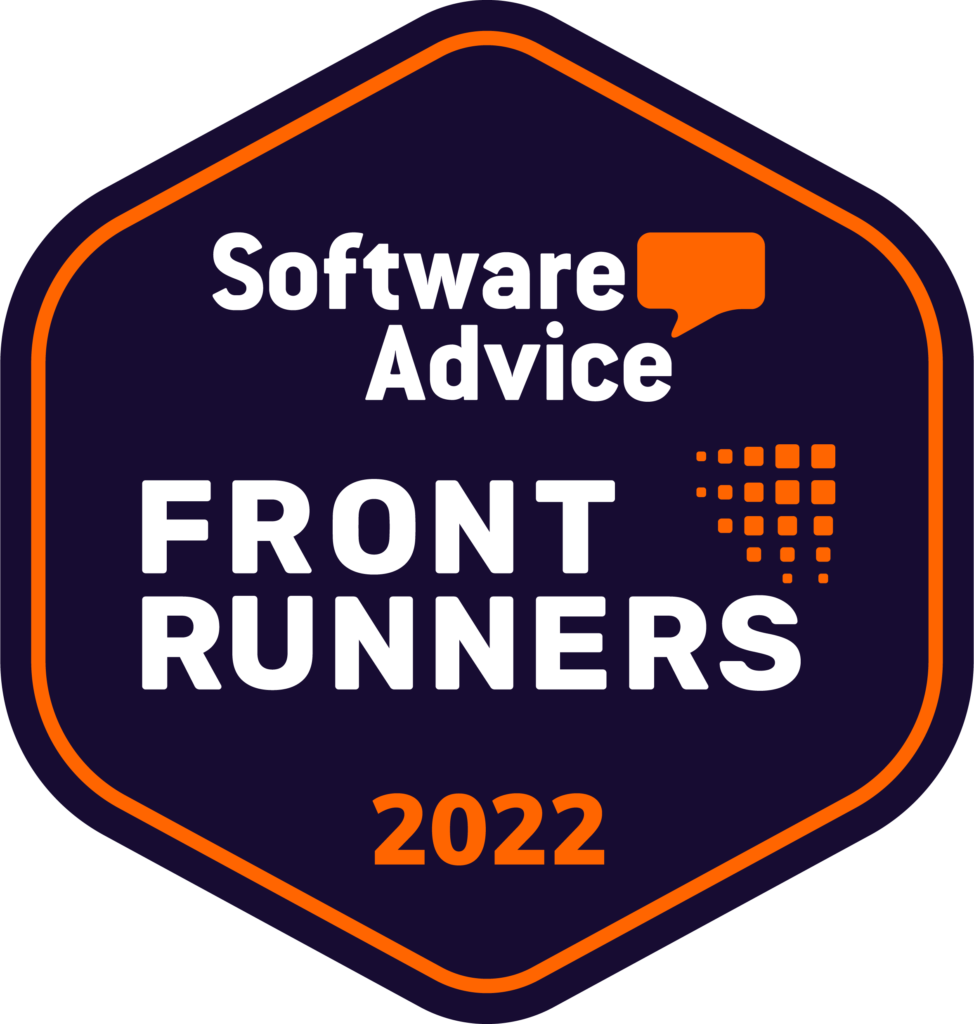Ever scroll through LinkedIn and see someone with high engagement in their posts? Wondering if there’s a secret trick you’re missing? The truth is, there’s no “perfect” LinkedIn engagement rate. But that doesn’t mean you can’t optimize your content to get those likes, comments, and shares rolling in.
In this blog, we’ll break down what engagement rate means and how to develop a strategy to keep your audience hooked and coming back for more.
Understanding LinkedIn Engagement Rate
LinkedIn engagement rate measures the level of interaction your content receives from your audience on the platform. It provides valuable insights into how well your posts resonate with your followers and connections. Essentially, it measures how actively your audience interacts with your content.
1. Formula for Calculating LinkedIn Engagement Rate
To calculate your LinkedIn engagement rate, use the following formula:
Engagement Rate = (Total Engagements / Total Impressions) x 100
Where
- Total Engagements = Sum of all interactions (likes, comments, shares, clicks)
- Total Impressions = Number of times your post was displayed
For example, if your post received 100 engagements and were seen by 1,000 people, your engagement rate would be:
(100 / 1,000) x 100 = 10%
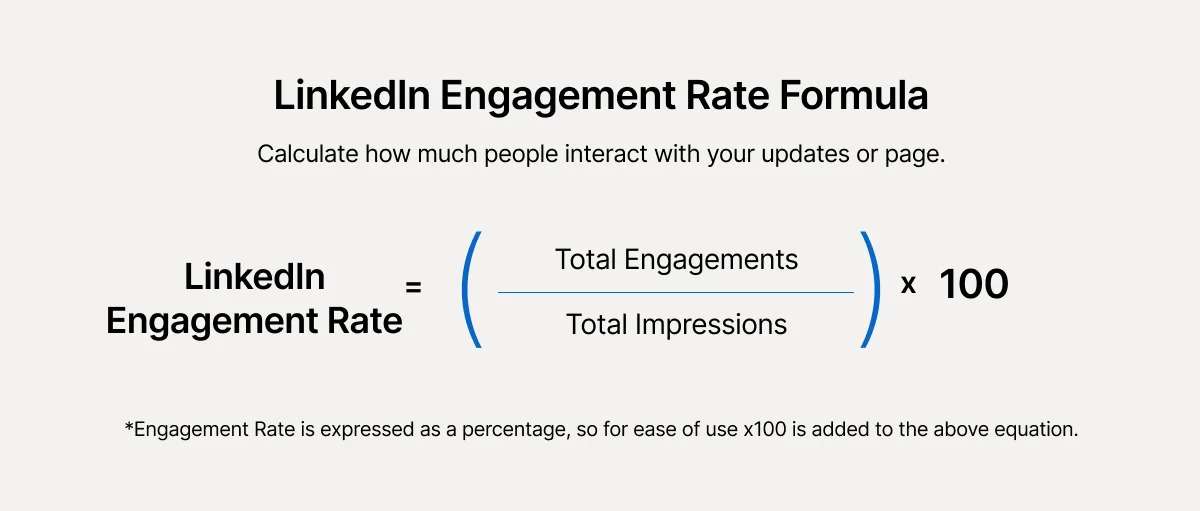
Source: authoredup.com
2. Types of Engagements on LinkedIn
LinkedIn considers various types of interactions to be engagements. These include:
- Likes: The most basic form of engagement showing appreciation for your content.
- Comments: More valuable than likes, as they indicate a deeper level of interaction.
- Shares: When users share your content with their network, expanding your reach.
- Clicks: Includes clicks on your content, links, or company name.
It’s important to note that LinkedIn’s algorithm values these engagements differently. Comments and shares typically carry more weight than likes or clicks. This is because they require more effort from the user and often lead to increased visibility of your content.
According to LinkedIn’s data from 2023, posts that include images receive 2x more comments than text-only posts. This highlights the importance of visual content in driving engagement on the platform.
Understanding these different types of engagements can help you adjust your content strategy to encourage more meaningful interactions with your audience.
Note: No doubt, a high engagement rate is desirable. It’s equally important to ensure that the engagement you’re receiving aligns with your professional goals and contributes to meaningful connections on LinkedIn.
Factors Influencing LinkedIn Engagement Rates
Understanding the factors that impact your LinkedIn engagement rate is important for optimizing your content strategy. Let’s explore the key elements that can affect your engagement levels on the platform.
1. Industry Differences
The average LinkedIn engagement rate by industry can vary significantly. Some industries naturally generate more engagement due to their content type or audience interest.
For example, technology and marketing sectors often see higher engagement rates than more traditional industries. For a more accurate comparison, it’s important to benchmark your performance against others in your specific field.
2. Company Size and Follower Count
Your company size and follower count can influence your engagement rate. Surprisingly, smaller companies often see higher engagement rates as they tend to have a more niche, engaged audience. Larger companies, while having more followers, might see lower engagement rates due to a more diverse and less personally connected audience.
3. Content Type
The type of content you post plays a crucial role in determining engagement. LinkedIn’s own data shows that:
- Posts with images receive 2x more comments than text-only posts
- Video posts earn 5x more engagement than any other type of content
- Document shares get 2x more clicks than posts with external links
This data explains the importance of visual and interactive content in driving engagement on LinkedIn.
4. Posting Frequency and Timing
How often and when you post can significantly impact your engagement rate. While there’s no fixed approach, consistency is the key. LinkedIn’s algorithm favors accounts that post regularly. As for the best timing to post, posting during business hours typically yields better results, as most LinkedIn users are professionals who engage with the platform during work hours.
5. Algorithm Changes
LinkedIn’s algorithm is constantly evolving, which can affect your engagement rate. The platform currently prioritizes content that sparks conversations and encourages meaningful interactions. Posts that receive quick engagement after publishing are more likely to be shown to a broader audience.
6. Quality of Connections
The quality of your connections matters more than quantity on LinkedIn. A network of engaged professionals genuinely interested in your content can lead to higher engagement rates. Focus on building meaningful connections within your industry or target audience.
7. Use of Hashtags
Strategic use of hashtags can increase your content’s visibility and, consequently, your engagement rate. LinkedIn recommends using no more than 3-5 relevant hashtags per post. Use a mix of popular and niche hashtags to reach a broad and targeted audience.
8. Interactive Elements
Including interactive elements in your posts can boost engagement. This includes:
- Polls: LinkedIn polls can increase engagement by encouraging direct participation
- Questions: Asking thought-provoking questions invites comments and discussions
- Call-to-actions (CTAs): Clear CTAs can guide your audience on how to engage with your content
By considering these factors and tailoring your LinkedIn strategy accordingly, you can work towards improving your engagement rate. Remember, what works best can vary depending on your specific audience and industry, so continually testing and refining your approach is important.
What is Considered a “Perfect” LinkedIn Engagement Rate?
Determining a reasonable LinkedIn engagement rate can be challenging as it varies based on several factors. However, understanding industry benchmarks and average rates can help you set realistic goals for your LinkedIn strategy.
1. Industry Benchmarks
LinkedIn engagement rates can differ significantly across industries. While specific rates can fluctuate, here are some general guidelines:
- Technology: 1.5% – 2.5%
- Marketing and Advertising: 1.8% – 3%
- Financial Services: 1% – 2%
- Healthcare: 1.2% – 2.2%
- Education: 1.5% – 2.7%
These ranges provide a starting point for evaluating your performance. However, remember that these are averages and top performers in each industry often exceed these rates.
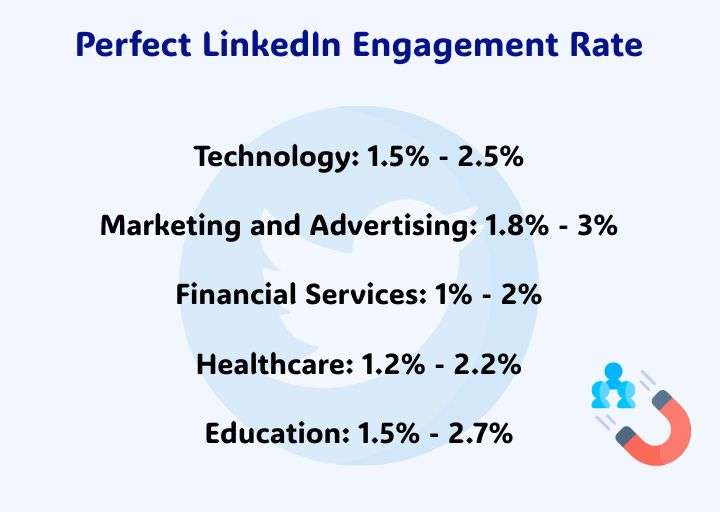
2. Average Engagement Rates Across LinkedIn
The average engagement rate across all industries on the platform is around 2%. This figure includes all types of engagements (likes, comments, shares, and clicks) divided by the total number of impressions.
It’s important to note that this average includes high-performing and low-performing accounts. Therefore, aiming for a rate above 2% is generally considered good, while rates above 5% are excellent.
3. Top-Performing Profiles and Pages
Top-performing LinkedIn profiles and pages often see engagement rates of 5% or higher. These accounts typically share high-quality, relevant content consistently and actively engage with their audience.
For example, LinkedIn’s official blog reported that some of the best-performing company pages on the platform achieve engagement rates of up to 8-10%. These pages often use a mix of content types, including thought leadership articles, employee spotlights, and industry insights.
4. Realistic Goals for Different Account Types
When setting goals for your LinkedIn engagement rate, consider your account type:
Personal Profiles
A good engagement rate for individual professionals typically falls between 2% and 5%. If you’re just starting out, aim for 2% and gradually work your way up.
Business Pages
Company pages often see lower engagement rates than personal profiles. A rate of 1-3% is considered good for most businesses.
Influencers and Thought Leaders
Established influencers and thought leaders on LinkedIn can see engagement rates of 5% or higher due to their dedicated following and high-quality content.
To truly gauge your performance, track your engagement rate over time and compare it to your historical data. This approach allows you to see your progress and identify the best strategies for your unique situation.
Lastly, don’t forget that engagement quality matters as much as quantity. A lower engagement rate with meaningful interactions from your target audience can be more valuable than a higher rate with less relevant engagements.
Strategies to Improve LinkedIn Engagement Rate
Improving your LinkedIn engagement rate requires a thoughtful approach and consistent effort. Here are some effective strategies for boosting engagement and making the most of your LinkedIn presence.
1. Optimizing Content for Your Audience
Creating content that resonates with your audience is crucial for increasing engagement. To do this, you can adopt the following strategies:
Understand your audience
Use LinkedIn Analytics to gain insights into your followers’ demographics, interests, and behaviors.
Share valuable content
Offer insights, tips, and information your audience finds valuable and relevant to their professional lives.
Use a mix of content types.
Incorporate text posts, images, videos, and documents to cater to different preferences. Remember, LinkedIn’s data shows that posts with images receive 2x more comments than text-only posts.
Write compelling headlines
Craft attention-grabbing headlines that encourage users to click and engage with your content.
2. Encouraging Employee Advocacy
Leveraging your employees’ networks can significantly boost your company’s engagement rate. Encourage employees to share and interact with company content by:
- Creating an employee advocacy program with clear guidelines and incentives.
- Providing employees with easily shareable content.
- Recognizing and rewarding active participants in the program.
3. Leveraging LinkedIn Features
You can also take advantage of LinkedIn’s features to increase engagement:
LinkedIn Live
Use live video to host Q&A sessions, webinars, or behind-the-scenes content. LinkedIn reports that live videos get 24x more comments than native videos.
LinkedIn Stories
Although this feature was discontinued, stay alert for any new, similar features LinkedIn might introduce.
Polls
Create interactive polls to encourage participation and gather insights from your audience.
LinkedIn Articles
Publish long-form content to establish thought leadership and drive deeper engagement.
4. Engaging with Other Users’ Content
Engagement is a two-way street. Actively participate in your network by:
- Commenting on and sharing posts from your connections and industry leaders.
- Joining and participating in relevant LinkedIn Groups.
- Responding promptly to comments on your posts to encourage further discussion.
- Consistency in Posting Schedule
Maintaining a consistent posting schedule helps build audience expectations and improves engagement. To achieve this, you should:
- Determine the best times to post for your audience using LinkedIn Analytics.
- Create a content calendar to plan your posts.
- Use scheduling tools to maintain consistency, especially during busy periods.
5. Experiment and Analyze
Continuously improving your engagement rate requires ongoing experimentation and analysis:
- A/B test different content types, posting times, and messaging styles.
- Regularly review your LinkedIn Analytics to understand what content performs best.
- Stay updated on LinkedIn algorithm changes and adjust your strategy accordingly.
By implementing these strategies and consistently analyzing your results, you can work towards improving your LinkedIn engagement rate.
Conclusion
Achieving the perfect LinkedIn engagement rate requires consistent effort and strategy. While industry benchmarks provide a helpful reference point, focusing on continuous improvement and meaningful interactions with your audience is essential.
By implementing the strategies discussed in this blog, you can enhance your LinkedIn engagement rate and maximize the potential of your professional network.
Remember, a higher engagement rate boosts your visibility and contributes to building stronger professional relationships and opportunities on the platform. Keep experimenting, analyzing your results, and refining your approach to achieve LinkedIn success.
You can try SocialBu’s robust scheduling and analytics tools to optimize your content strategy and effortlessly boost your LinkedIn engagement rate. Sign up for a free trial today and see the difference.
FAQs
1. What is engagement on LinkedIn?
Engagement on LinkedIn refers to any interaction users have with your content, including likes, comments, shares, and clicks on your posts or profile.
2. How do you calculate the post engagement rate on LinkedIn?
The post engagement rate on LinkedIn is calculated by dividing the total number of engagements (likes, comments, shares, clicks) by the total number of impressions, then multiplying by 100.
3. What is the best engagement on LinkedIn?
The best engagement on LinkedIn involves meaningful interactions that lead to professional connections, discussions, and opportunities. Comments and shares are generally considered more valuable than likes.
4. What is the engagement rate?
Engagement rate is a metric that measures the level of interaction your content receives relative to your audience size or reach, expressed as a percentage.
5. What is a 2% engagement on LinkedIn?
A 2% engagement rate on LinkedIn is considered average across all industries, meaning that 2% of the people who see your post interact with it in some way.
6. Is 3000 impressions on LinkedIn good?
Whether 3000 impressions on LinkedIn is good depends on your follower count and industry; for small to medium-sized accounts, this can be considered a solid performance, but higher numbers might be expected for larger accounts or viral content.
